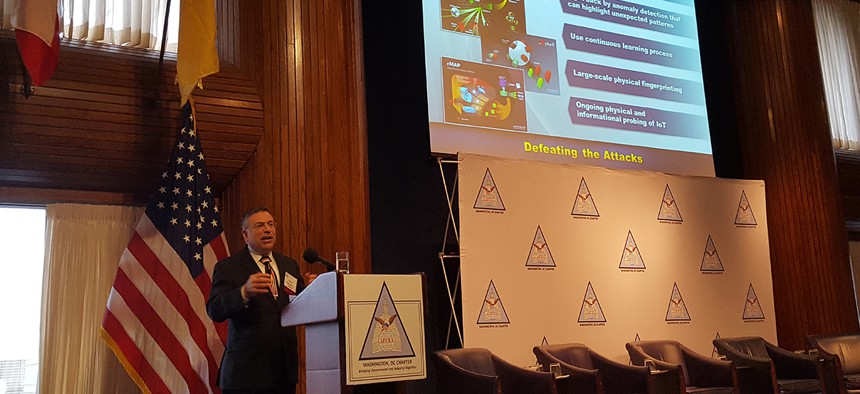sponsor content What's this?
The Internet of Things for the Battlefield Needs to Be Flexible, Army Official Says

IICSAII
Presented by
FedTech

To serve the soldiers of the future through connected devices, the military will need dynamic and adaptable networks.
The Internet of Things is coming to the military in a big way, probably sooner than most think, according to the Army’s John Pellegrino. To make sure that tomorrow’s warfighters have all of the tools they need to take advantage of IoT, the Department of Defense and armed services branches will need highly flexible and responsive networks that can deal with limited bandwidth, he said.
Speaking May 17 at an AFCEA DC event, Pellegrino, deputy assistant secretary of the Army for strategic integration, said that “we can serve the warfighter better with more intelligence and more ways to coordinate actions amongst themselves.”
The DOD and Army are currently doing so in limited ways, but Pellegrino says that in 20 years the IoT “will be ubiquitous.” He also said that predictions made by people like him are usually understated. “We tend to put things out many years in the future that are probably only a couple of years away,” he said. “When I say 20 years, it’s probably a lot sooner than that.”
Yet for the Army and wider military to make the most of IoT, it will need to rely on heterogeneous and flexible networks that use different kinds of equipment, continue to operate in environments with spotty connectivity, and don’t place burdens on soldiers.
Internet of Things Use Cases
The DOD has been using IoT in various ways for years, Pellegrino noted, especially for managing its energy usage and physical infrastructure. Connected energy management solutions have allowed the military to reduce total energy consumption by 23 percent since 2002. The military has about 8,000 smart meters installed, with 66 percent of them reporting to an integrated management system. Connected water management has allowed the military to cut portable water use intensity by 27 percent since 2007, he said.
Other use cases for IoT include fully immersive virtual simulations for soldiers’ training; autonomous vehicles; the ability to use smart inventory systems to consolidate warehouses using a web-based delivery and inventory system; and business systems like the Army Strategic Management System to manage energy, utilities and environmental sensors.
Pellegrino said some connected devices will be intelligent, and others will be “marginally intelligent” but that connectivity will spread everywhere, from munitions to weapons, robotics, vehicles and wearable devices. All of these devices will generate an enormous amount of data, he said, and the military needs to figure out how to make that data useful.
“All of these devices are going to be performing a massive variety of tasks,” Pellegrino said, including recommendations on where and when to attack and defend, and which of them will need to be coordinated.
Having a Flexible Network Is Key
Pellegrino notes that the battlefield situations the military operates in “range from the moderately stable to very high dynamic situations.” To support IoT, the military’s networks will need to be flexible and interactive, he said, and still work despite limited bandwidth, intermittent connectivity and with a large number of devices on the network.
The arrangement of those networks needs to be done “totally autonomously,” he said. The military’s partners may be changing depending on the mission, and connected devices will need to work across networks with different network equipment and configurations.
“To achieve changing objectives with multiple complex tradeoffs, we have got to have highly adaptive management and organization leading to action, with no burden on the soldier, either cognitive or physical burden,” Pellegrino said.
These IoT networks will need to deal with multiple threats from adversaries, Pellegrino said, including physical attacks on infrastructure, direct energy attacks, jamming of radiofrequency channels, attacks on power sources for IoT devices, electronic eavesdropping and malware.
The military will need to deal with cyberattacks through the civilian Internet as well, since in some cases armed forces will need to rely on those networks. “Since our networks are an agglomeration of mobile, fixed and satellite, we have a proximity issue,” he said, noting that there are numerous entry points and vulnerabilities.
Despite the focus on connected things, Pellegrino said that humans will be the elements within networks that are most vulnerable to deception, and humans will be handicapped when they are concerned that information they are receiving via the network is untrustworthy, even if that concern is misplaced.
The military can take all kinds of measures to counterattack cyberattacks on IoT networks, Pellegrino said, including injecting fake code meant to attract and catch intruders, using disposable connected devices, large-scale physical fingerprinting and ongoing physical and information probing of IoT networks. The military will also need to look at the “psychosocial behaviors” of attackers and see if they can discern patterns of behavior, he said.
A key challenge with IoT, Pellegrino said, is “sheer complexity” of the network environment, with devices operating in networks and channels the military doesn’t own. He also said that a world in which there are “millions of [connected] things per square kilometer is not very unreasonable.”
“We are going to have to adapt very rapidly,” Pellegrino concluded.
This content is made possible by FedTech. The editorial staff of Nextgov was not involved in its preparation.


